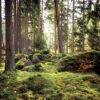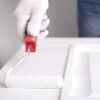Extensive information about the latest professional knowledge about wood and natural enemies of wood. Protects wood against water and makes it durable. Benefit now from our expertise.

An understandably popular material
Wood, the material of nature
Premium protection based on nature’s example
Trees already have the best natural wood preservation possible - the bark. This protects the wood against drying out and especially against diverse weathering factors like the sun, wind, rain, frost and heat. All the important nutrients that the tree needs to grow and flourish are supplied via the roots. Thanks to this supply system, the life of the wood is protected for centuries and forms an environment and shelter for humans and animals. With its products, Remmers has set itself one goal: to give the construction wood the same optimum protection in the form of advanced paint systems, wood stains and primers. With its almost unlimited variety of colors and structures, the wood gives shape to this completely new range of wood protection systems for the professional in a unique way.
The natural enemies of wood

Moisture
Outdoor wood is permanently exposed to moisture: Rain, dew, condensation etc. increases the moisture level, and evaporation decreases it. The consequence: Cracks in the surface. Moisture that penetrates the wood through these cracks or by means of diffusion needs to leave the wood again, otherwise waterlogging occurs below the surface, which is a breeding ground for blue stain and wood-damaging rot.
Dimensional stability is cruicial for windows, doors and facade carpentry. High-solid stains are used here. Moisture absorption is prevented with this treatment and the wooden elements no longer change in size due to expansion and contraction, so that windows and doors always open and close properly.
With so-called non-dimensionally stable components, e.g. paneling, fences and garden sheds, it is not possible to completely rule out the possibility of moisture penetration e.g. via the end-grain woods or due to cracks. It is important to use and impregnation stain at this point so that the wood can continue to breathe (vapour open) and the moisture can leave the wood again.
UV rays
The sun not only affects the temperature of the wood surfac, but the UV rays also penetrates into the wood. In combination with rain, it can change the colour of the unprotected wood in a few weeks or months, i.e. the wood appears silver-grey. The wood surface then also has fine wood fibres that stand upright on the surface, causing the wood to lose its strength. These often undesirable colour and surface changes can be prevented when wood is treated with a pigmented paint or stain. For the first time, MSL-40 and Aqua MSL-45 in transparent UV+ allow the application of a transparent coating to wood used outdoors that, thanks to the highly effective UV blocker, delays the greying effect.
Algae
These lower organisms ensure green discolouration and an optical impairment of wood outdoors, in particular in wooded or forested areas. HSL-30, MSL-40 and Aqua HSL-35 are algicides and prevent premature green discolouration. Other water-based coatings from this range can also be mixed with Protect MKT1 algicide.
Blue stain
Blue stain is a so-called wood staining fungi and is visible as black-blue discolouration. Blue stain does not destroy the wood, it only impairs its appearance. However blue stain paves the way for wood-damaging fungi (rot), because it perforates the cell walls and facilitates better water absorption in the wood (capillarity).
Rot
Rot is the most dangerous form of damaging fungi. It destroys the structure of the wood. The wood loses its stability: It becomes rotten.
Wood-damaging insects
In addition to the wood staining and destroying fungi, parasitic animal infestations also attack the wood. For instance,the house longhorn beetle is one of the most dangerous wood-damaging insects in moderate climates and is particularly prevalent in soft wood. It lays its eggs in existing cracks and the grubs like to eat the outer layers. The damage caused by other wood-damaging insects also follows a similar scheme: The insect lays the egg in or on the wood. The grub hatches from the egg - the grub is the actual destroyer of the wood.
Durability of wood types
Wood refinement? When is additional wood preservation needed?
Depending on the durability of the wood type that is used, a decision can be made about the necessity for a chemical wood preservative for wood that is used outdoors. A finish with biocide-free products is usually enough for ‘very durable’ and ‘durable’ woods. ‘Moderate’ to ‘non-durable’ woods also require a chemical wood preservative, e.g. to protect against blue stain and rot. The wood types are only classified based on the heartwood. However, usually, conventional woods also contain some sap wood that is not generally classified as durable. These kinds of woods should therefore not be used outdoors without a chemical wood preservative.
Structural wood protection
As a result, damage by moisture no longer has a chance
Constant moisture load is the main cause of discolouration and wood-affecting fungi. To exclude this as well as possible, wooden components must be placed outside in such a way that contact with water is prevented as much as possible. If this is not possible, ensure that the wood can dry again quickly. Also exclude load from standing water. Measures for structural wood protection are, for example, spacious roof overhangs, no direct contact with the ground (prevent splashing water), sloping surfaces, rounded edges and covering of horizontal parts. For even better protection, the wood can, if desired, be treated before it is finished with a decorative layer with an officially approved wood preservative (eg Wood Protect).
Application information for modern, water-based products
Water-based wood coatings are widely used today. An optimum result can be achieved if the following points are taken into account:
-
General handling and application
-
Suitable tools and cleaning
-
Ambient and drying conditions
-
Adhesion to old paintwork
-
Sanding
-
Thinning
-
Insulating effect

